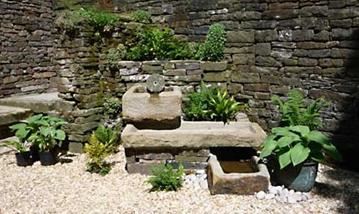Creating A Water Feature In Your Garden - UK Water Features

The hardest part of adding a water feature to your garden is choosing which one, once you’re over that hurdle the installation is quite straightforward and can be completed in a weekend, or less if you opt for a ready-made freestanding item.
If you have chosen the latter, a ready-made freestanding feature including an integral reservoir, then you simply need to choose a location. When doing this you should take into account the amount of sunshine the feature will receive as this will affect how much algae can form in the water; also whether the feature will be subjected to high winds and most importantly your view of the item. Should it be against a wall for stability or can you enjoy it from any angle?
Once you have decided you need to consider the power supply, do you have armoured cable laid in your garden that you can connect the feature to? If not you will either need to lay cable or connect the feature to a mains supply, via an RCD, ensuring any connections are protected from weather or sited inside. Then you should simply provide a firm, level base, and install the feature as per the included instructions. Fill your reservoir, add your pump and turn on so you can adjust the flow to create the desired effect, then add any decorative elements and you’re done.
Creating a feature from scratch is a slightly more involved but requires the same basic considerations. Choose a location and then you need to prepare the groundworks for the reservoir. Whatever shape reservoir you have you need to give it a firm, level base so mark around it and dig a hole, allowing the reservoir to sit slightly above ground level so that soil won’t fall in. You may need to add a layer of sand or concrete to give plenty of support to the base and also to the edges if you’re using a grid which will overhang. Trial fit the reservoir to ensure it’s just right, it is worth taking your time at this stage. If you have a pond liner instead of a pre-formed reservoir you will need to remove any stones and roots from the excavation, add a layer of sand and underlay if you wish, then add the liner, pushing it into all recesses. Trim off some of the excess then add the pump and fill the reservoir to allow the liner to settle.
You should now fit your metal grid or reservoir lid, adding any additional holes to accommodate the hose or wiring. Thread the hose through the lid/grid and loosely fit to the feature then connect your power supply and run the pump so that can adjust the flow to create the desired effect. You may need to tape or silicon the hose into place in the feature if you have created your own from a drilled monolith for example. Additional strength can be added by placing cement blocks in the reservoir to help distribute the weight of the feature. Once you’re happy with this you can turn off the pump, fit the access hatch and go about finally arranging your feature, adding decorative stones or plants, remembering to make sure you can still get to the hatch easily for maintenance. If you have a pond liner you should finally trim it and cover over the edges. Then it’s time to turn the pump back on, stand back and enjoy!
Especially after the initial set up you should regularly check the water level to ensure the pump is fully submerged at all times. Periodically turn the pump off, remove it and clean it out. If the water starts to develop algae simply add a water treatment to clear it, then a preventative to stop it forming again.
UK Water Features has over 1,500 both indoor & outdoor water features now online.
This article was written by Water Bucket Walter







